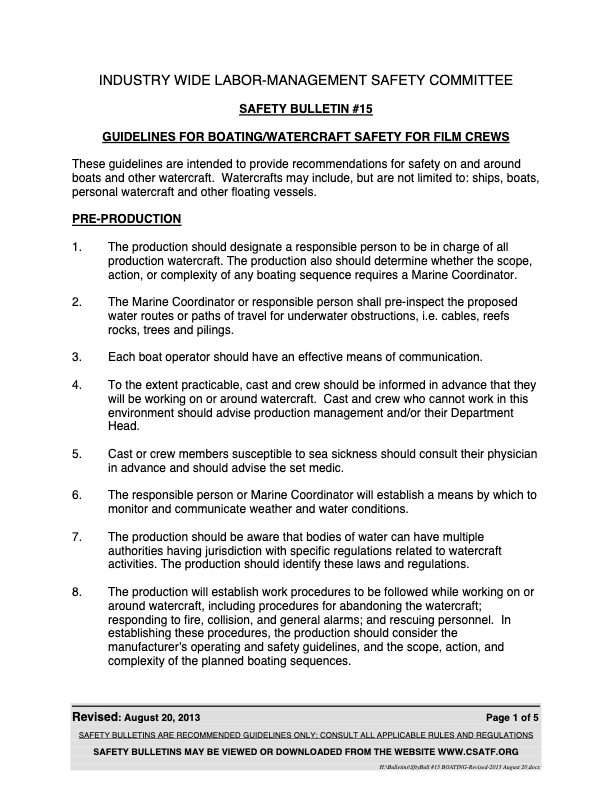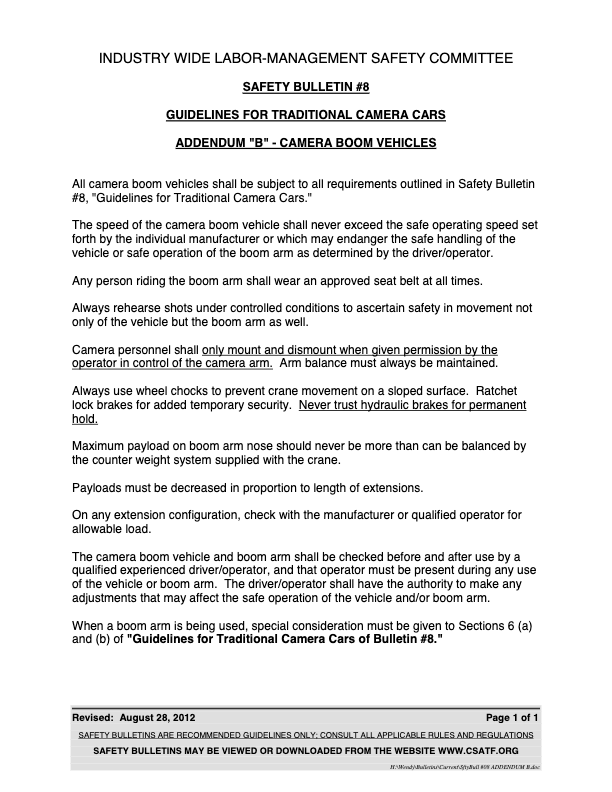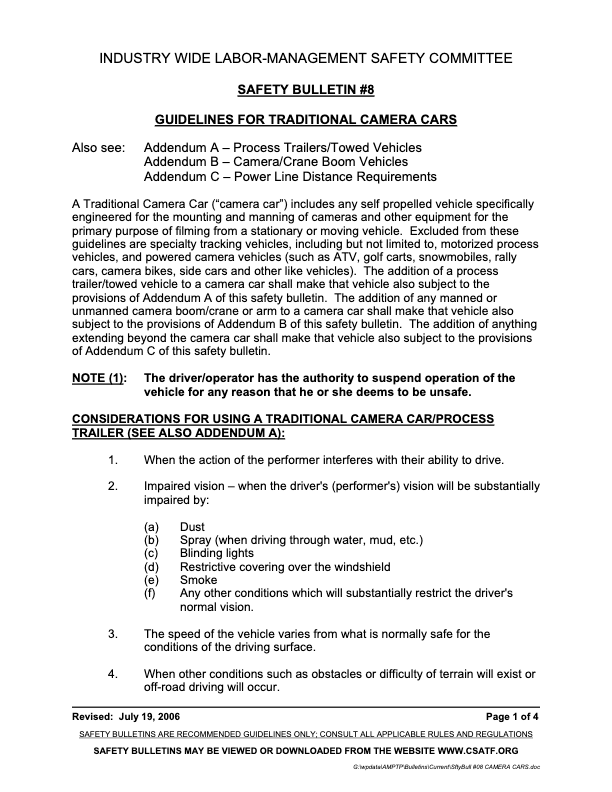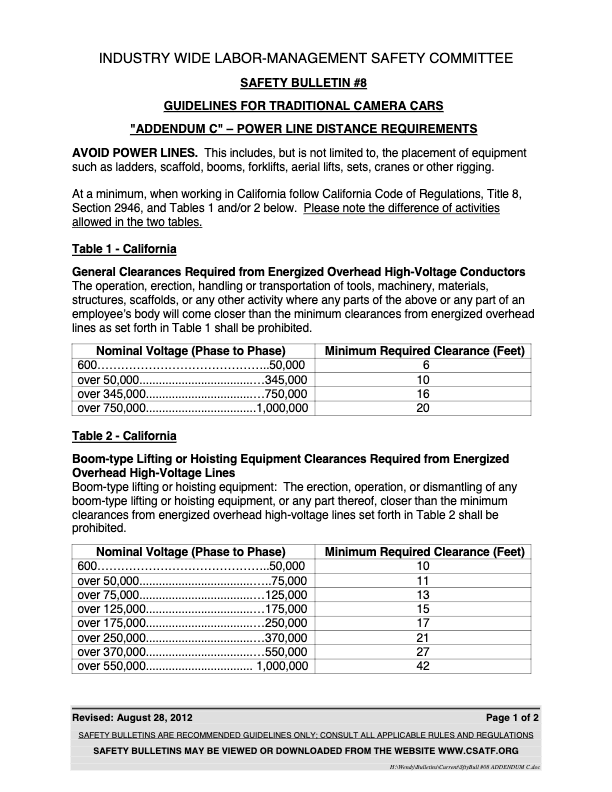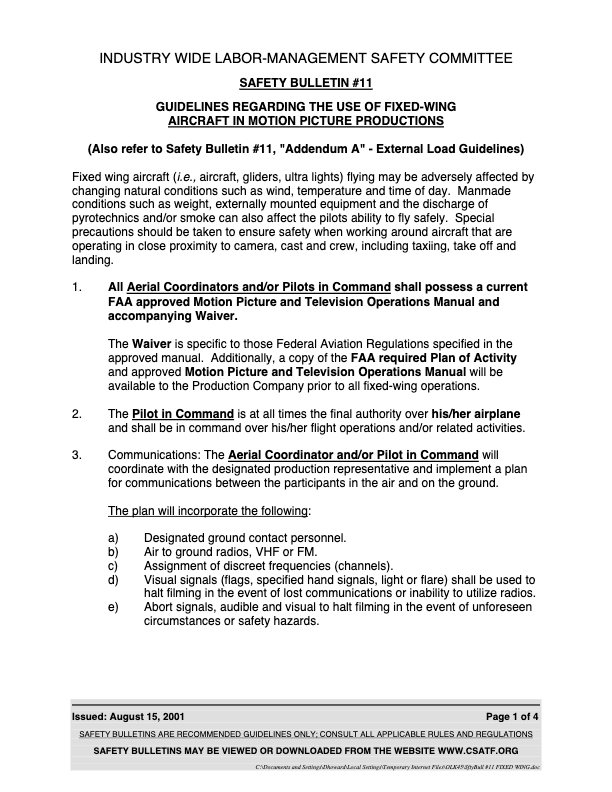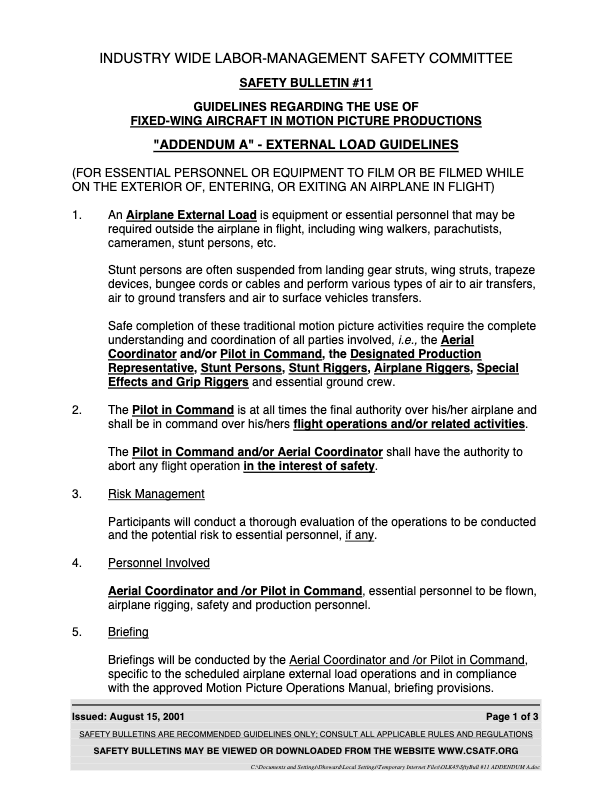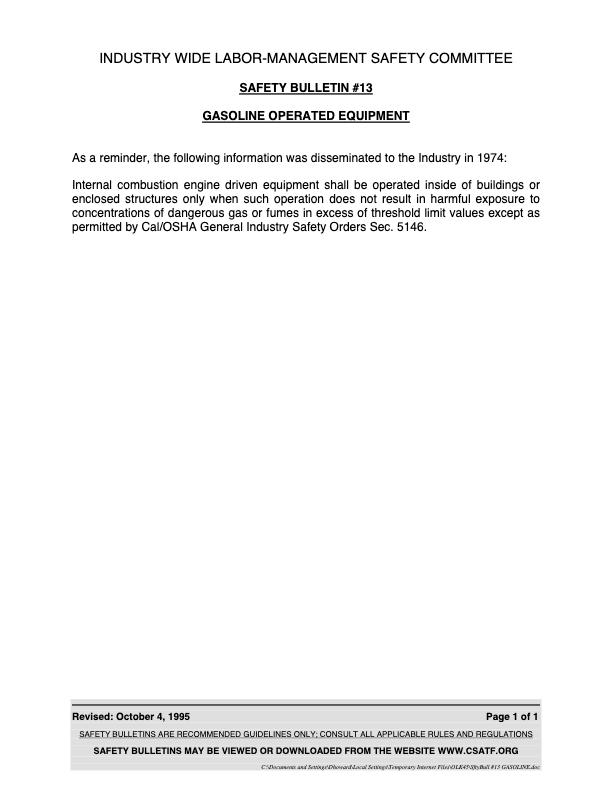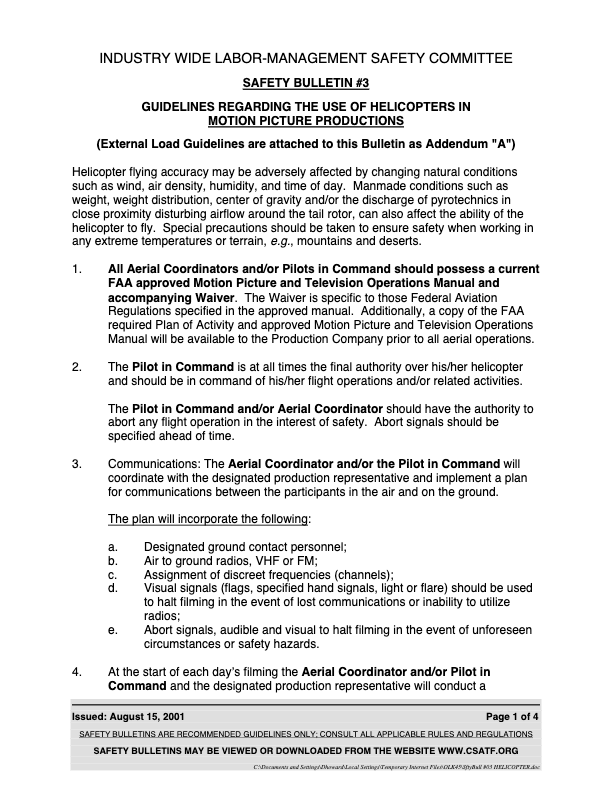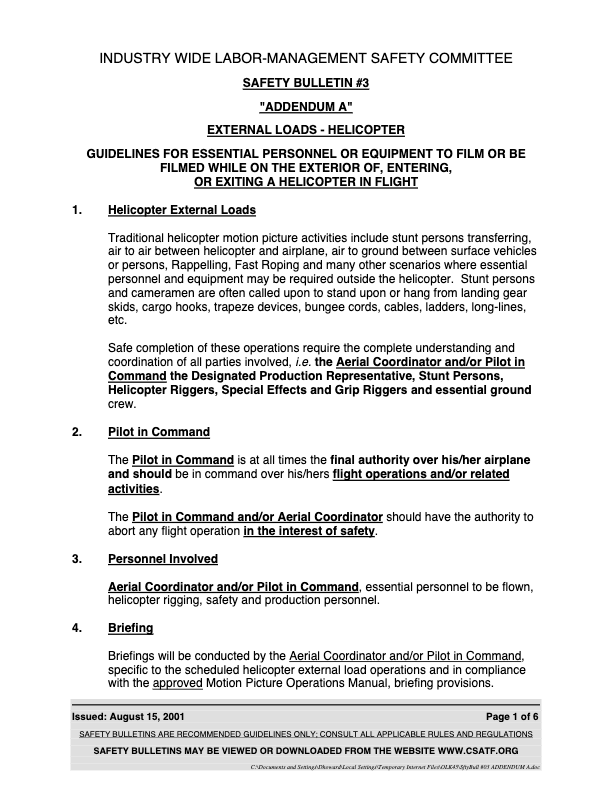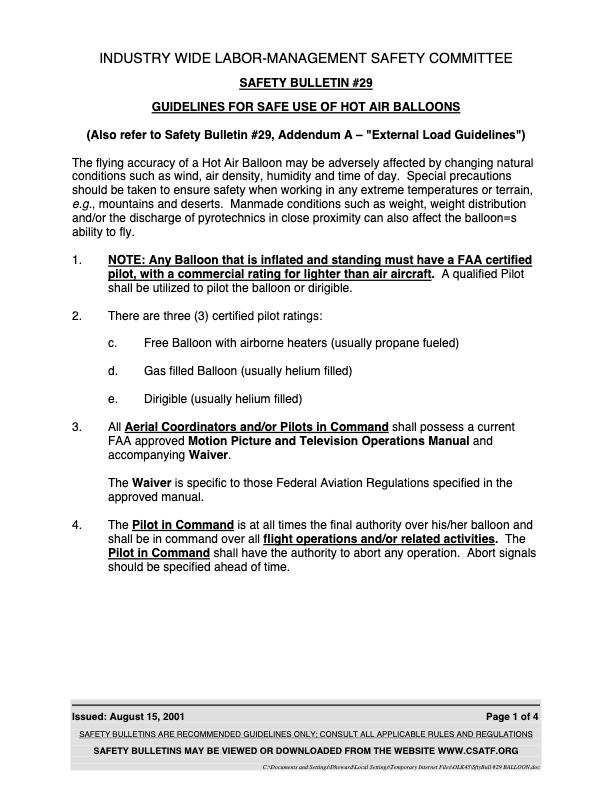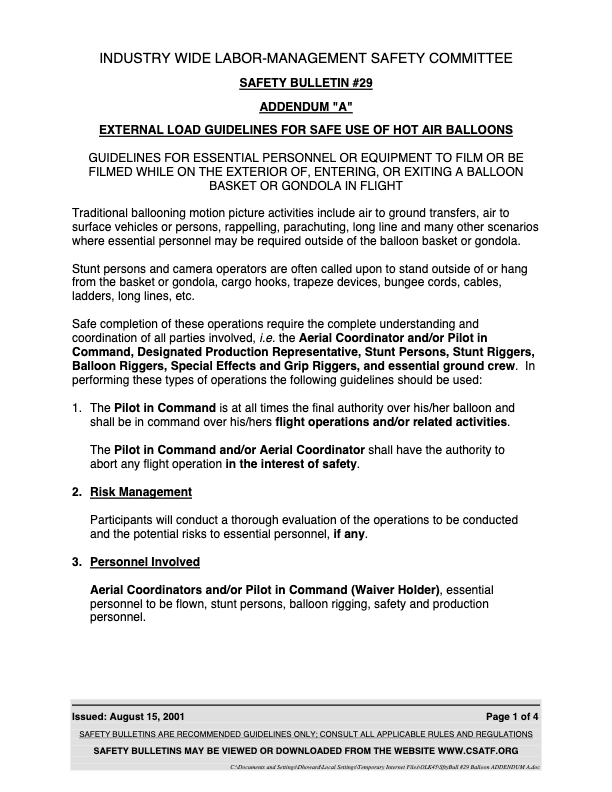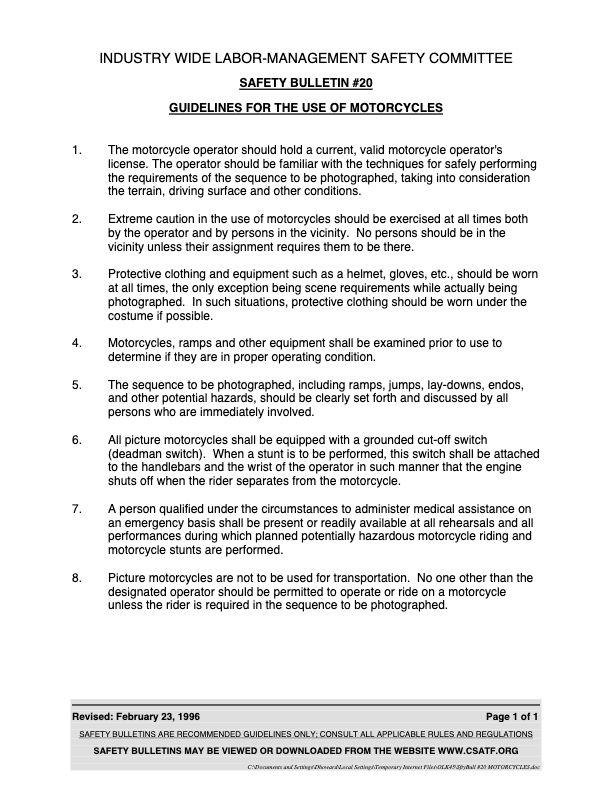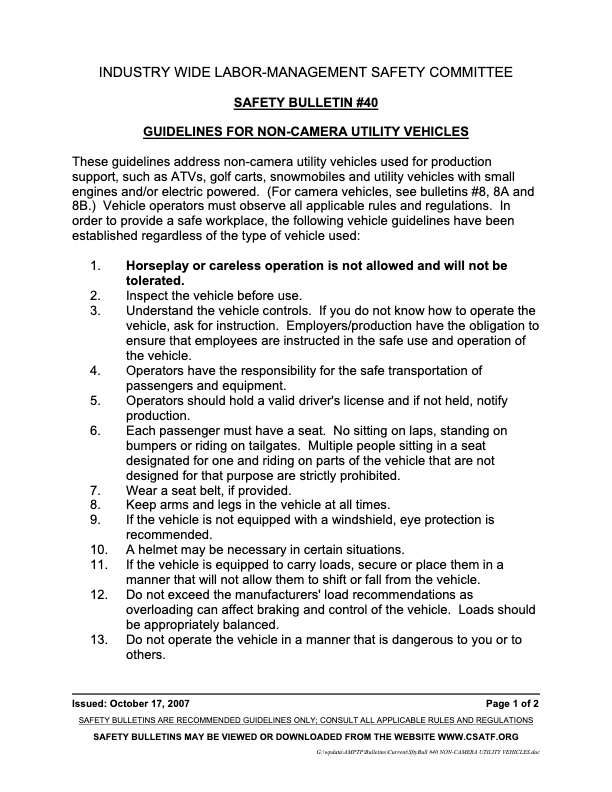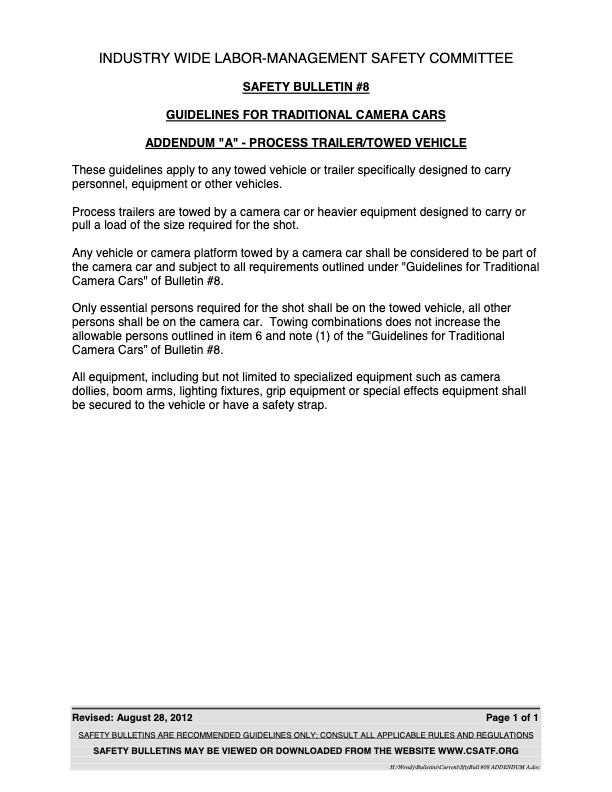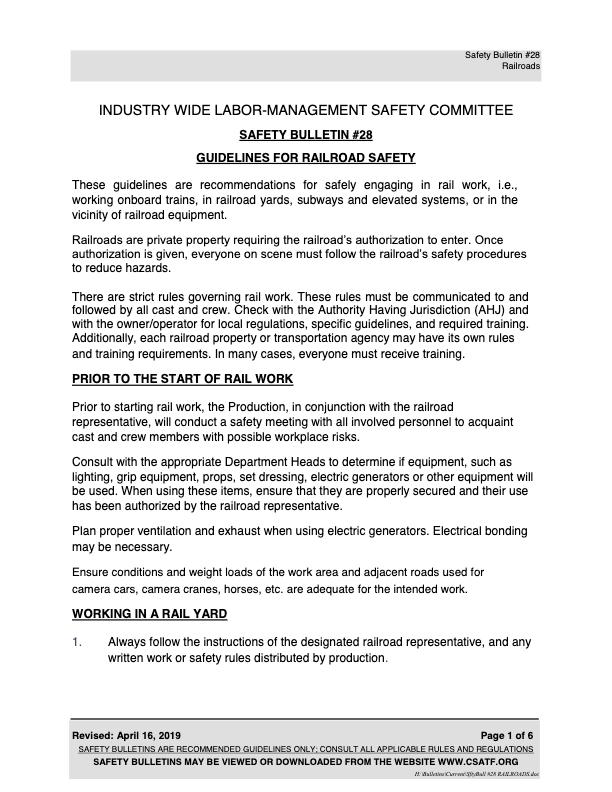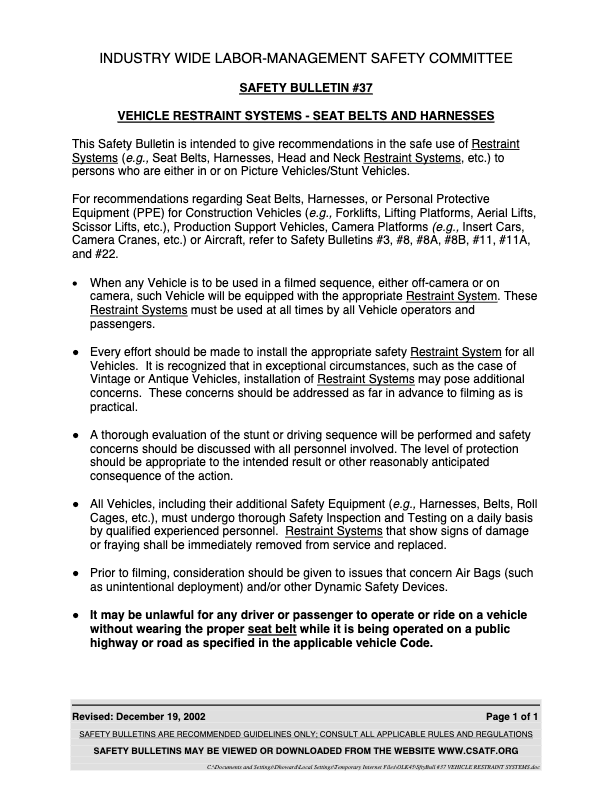Safety Bulletin

Guidelines
The term “Free Driving” applies to situations where the driver or a passenger of a vehicle is being photographed by cameras attached to the outside and/or inside the vehicle, or being handheld by a camera operator inside the vehicle. The term free driving also applies in situations when the camera is used to film external shots from in or on the vehicle. For example, during Free Driving the camera can be attached to the exterior of a vehicle with a door mount (hostess tray), a hood mount, or on a mechanical track system. As a result of unique vehicle configurations, equipment placement, personnel location and operations, potential risk factors may exist and should be addressed, as discussed below.
These guidelines do not cover insert car and/or process trailer operations. For those situations, refer to Industry-Wide Labor-Management Safety Committee Safety Bulletin #8 “Guidelines for Traditional Camera Cars” and/or #8, Addendum A “Process Trailer/Towed Vehicle” for guidance. Also refer to Safety Bulletin #37 “Vehicle Restraint Systems – Seat Belts & Harnesses” and #42 “Guidelines for Alternative Driving Systems”.
Considerations Before Engaging in Free Driving
Production shall consider all available options (including camera car, process trailer, alternative driving systems, etc.) and assess and make the determination that Free Driving is an appropriate method.
Driving safely is the first priority; acting and/or getting the shot is second. When safe operation of the vehicle is not possible, alternate means should be used, such as a process trailer or a tow vehicle.
Unsecured equipment poses a particular challenge. Hand-held cameras, equipment, and crew and actor placement should be considered to ensure the equipment will not become a projectile that could cause injury.
Other considerations for safe Free Driving include:
- Scene action (e.g. stunts, performance, and special effects)
- The ability of the driver to simultaneously perform, drive, and remain aware of any clearance required for rigging or equipment that extends beyond the vehicle body
- Controlled or uncontrolled environment (closed course versus open roads with Intermittent Traffic Control (ITC))
- Location permitting requirements, such as for road closures, ITC or driving grids.
- Type and condition of vehicle to be used
- Intended speed and maneuvers
- Operating the vehicle in close proximity to other vehicles
- Route conditions (e.g. curved, incline, crown, obstacles, clearances, length, width, paved, gravel, dirt, flat, hilly, wet, or slippery)
- Anticipated weather
- Airbags and other automatic devices may need to be deactivated for safety, depending on the placement of personnel and equipment (e.g. cameras, lights). NOTE: Only a person who is trained, qualified, and authorized to disengage an airbag shall do so.
- If airbags must be disabled, alternative safety measures will need to be implemented (e.g. restraint harnesses).
- The production should consider road closures, reduced speeds, etc. prior to disengaging airbags.
- Equipment weight, load capacity, center of gravity, counter balance, placement and use (e.g. camera, lighting, and props)
- Limited lighting options, including placement and power
- Limited visibility conditions for the driver (e.g. cameras, mounts, dust, spray, lights, restrictive covering over the windshield, smoke)
- Communication system (e.g. walkie-talkies)
Prior to Operation
- When vehicles are used for filming, all rigged equipment must be securely mounted. If cameras are mounted to any part of the vehicle (either inside or out), these must be securely installed with the appropriate mounts / restraints and by a member of the crew who is qualified to perform the procedure.
- Mounted equipment inside or outside the vehicle should not obstruct the driver’s view or distract attention while the vehicle is in motion.
- No lighting should be used within the vehicle that could impair the driver’s clarity of vision or provide distraction.
- The consideration of foreseeable emergencies (e.g. deployment of vehicle airbags) must be taken into account when positioning the camera operator.
- The driver must be qualified to operate the vehicle and should have an appropriate license. NOTE: A license may not be required by law. However, drivers may need special training to be qualified to drive an unfamiliar vehicle or course.
- All rigging of the vehicle and equipment, including cameras and lights, is to be performed by qualified personnel in a secure area which is free of known hazards, including other vehicular traffic.
- A walk-through with the driver should be conducted to familiarize them with the operational characteristics of the vehicle and controls. Always check that the driver can operate the vehicle safely while filming is taking place.
- Establish communication between drivers and support vehicles (e.g. walkie-talkies).
- Check the weather and road conditions; establish the route, ensure that it is clear, and allow enough time for rehearsals prior to filming.
- Brief the driver regarding the proposed filming plans. Ensure that the driver is confident with the route and is aware of where the cameras will be positioned.
- The driver should do a test drive of the vehicle to familiarize themself with the filming plans and where they need to drive during the scene.
- After rigging cameras and other equipment, carry out a test drive in a secluded spot or private road to test that the clamps have not come loose through vibrations. This process should be carried out each time you stop as a secondary check.
Inspection
Ensure the vehicle has been inspected, is roadworthy, and has been suitably maintained. Inspection items include, but are not limited to, brakes, steering, tires, engine, drive train, vehicle’s electrical system, connection points, equipment placement, and all safety equipment. Any items not functioning properly must be repaired by a qualified person before use.
Safety Meetings
A shot‐specific safety meeting should be held by the First Assistant Director for all personnel riding in or on the vehicle, including those in close proximity (e.g. stunt personnel or background performers). This meeting should discuss the following topics:
- Shot sequence and route (e.g. stunt action including crossovers/head‐on or near misses, vehicle speed, number and proximity of other vehicles, crew and camera placement, background performers, and property)
- The potential use of a convoy of safety buffer vehicles for a cushion zone, plus slower travel speeds
- Walk‐through or dry‐run
- Environmental conditions (e.g. weather, surface conditions such as cement, gravel or dirt, topography such as flat or hilly)
- Possible changes due to hazards
- Authority to abort, including signals to be used
- Route conditions (e.g. slope, curved, incline, crown, obstacles, clearances, length and width)
- Equipment considerations (e.g. rigging, cameras, lights, microphones, airbags)
- Communication systems (e.g. intercom and designated channel)
- Signaling system to alert personnel to the vehicle’s impending movement
- Visibility
- Special effects
- Personal protective equipment (e.g. harnesses, seat belts, helmets, eye protection)
- Traffic and pedestrian control (e.g. street closures, ITC)
- Emergency plan (e.g. escape routes and contingency plan)
If there is a substantive change in the choreography, equipment, or personnel involved in the shot, the individuals involved should discuss and decide if a subsequent safety meeting and rehearsal should be held.
Operation
Depending on the road conditions, speed, weather, controlled/uncontrolled environments, etc., the following should be considered during rehearsals and filming:
- Only essential personnel required for the shot should be allowed on or in the vehicle.
- Equipment and personnel should not disrupt, distract the driver, or compromise the safety of the vehicle operation.
- Cast and crew riding in the vehicle must be provided a safe and secure place to ride.
- While filming from inside the vehicle, personnel should be restrained with suitable straps/harnesses. The camera and gear should be properly secured.
- A generator, when needed, should not be positioned where the cast and crew may be exposed to the exhaust.
- If using batteries with or without an inverter, the batteries must sit flat and be secured in an upright position. Batteries can get hot and should not be placed against anything combustible.
- When possible, a remote ON/OFF control switch should be used to run and stop the camera when it is door or hood mounted; a camera assistant rushing to the car to turn off the camera can create a hazard.
- The performer should not be tasked with “slating” if the vehicle is already in motion.
- Use comms/walkies to communicate between all parties.
- Driver should keep within legal speed limits and drive within the law, safely and responsibly to ensure that driving actions do not cause any hazards to oncoming traffic/drivers (if applicable).
- After each run, a general inspection should be conducted to ensure all equipment is secure. If at any time a camera or other equipment is deemed to be “unsteady,” filming should cease and adjustments made accordingly.


